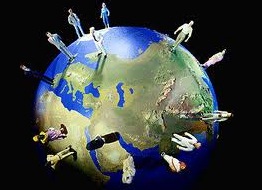 One of my recent blog posts reviewed an article by Brannen and Thomas (2010) on the topic of bicultural employees. The article gives an overview of what ‘bicultural’ is and emphasises the importance of this emerging demographics for organizations. Yet, I think the question of ‘what is the practical contribution of bi- or multicultural employees to global organizations’ needs further elaboration.
One of my recent blog posts reviewed an article by Brannen and Thomas (2010) on the topic of bicultural employees. The article gives an overview of what ‘bicultural’ is and emphasises the importance of this emerging demographics for organizations. Yet, I think the question of ‘what is the practical contribution of bi- or multicultural employees to global organizations’ needs further elaboration.
The scholars Fitzsimmons and her colleagues (2011) address that question by bringing up the practical value of multicultural employees. The authors argue that multinational employees contribute to five key activities of global organizations, which I will discuss further below.
First of all, Fitzsimmons et al. (2011) argue that multiculturals impact on teams, by making them more diverse. Certainly diversity in itself (within age, culture, background etc) usually implies more creativity in teamwork, however multicultural employees bring additional benefits. Being representatives of one or more cultures, such employees act as ‘bridges across cultural faultlines’ (p. 200) thus making the ‘us versus them’ thinking and division within the group based on cultural affiliation more difficult. Further, diversity is good because a multitude of different perspectives are brought to the table. However, it also takes time to arrive at a common opinion because of misunderstandings and differences in values. In contrast to monoculturals, multicultural individuals are less likely to produce such conflicts because they share cultures and values with other teammates. Finally, multiculturals are less prone to conformity and groupthink, as they ‘bring more new ideas and unconventional solutions to the team than monoculturals’ (p. 201).
The second area of benefits from multiculturals involves intercultural negotiations. The authors see an advantage of having multiple cultural backgrounds in that these individuals have an ability to see things from another person’s viewpoint (good perspective-taking abilities). Also, they might be more effective in communicating within a cross-cultural negotiation setting, which positively influences the negotiation partner’s experience as well.
Third, multiculturals impact on expatriation. Specifically, the authors state that multicultural individuals excel as expatriates mainly due to their cultural mindfulness, which is a heightened awareness of cultural cues, and an increased ability to identify with both parent and host country organizations.
Next, multiculturals have an impact on ethics and leadership. Doing business globally may at times post a dilemma between universally accepted ethics and the ‘when in Rome do as the Romans do’ attitude. The authors note that multiculturals’ experience seeing the world from more than one perspective helps them to reconcile such dilemmas and clarify when different is just different, or wrong.
Finally, a multicultural background benefits the process of cross-border alliances, mergers and acquisitions. Multiculturals’ cultural empathy and their abilities to bridge cultural gaps and take another party’s perspective are useful for evaluating the cultural fit between the organizations to be merged during the due diligence stage, and also help out during the integration stage after the merger has taken place.
All in all, it seems that the benefits derived from multicultural employees compared to monoculturals are based on their better understanding of cultures in general, their global consciousness and their multiple perspectives. I would argue that all these positives reflect a competence that has been called ‘cultural intelligence’. So by developing employees to be culturally intelligent organizations might derive benefits not only from multiculturals but also from originally monocultural individuals. Let me elaborate on this question in my next blog post.
Further reading:
Brannen, M. Y., & Thomas, D. C. (2010). ‘Bicultural individuals in organizations: Implications and opportunity’. International Journal of Cross Cultural Management, 10, 1, 5-16.
Fitzsimmons, S. R., Miska, C., & Stahl, G. K. (2011). ‘Multicultural employees: Global business’ untapped resource’. Organizational Dynamics, 40, 3, 199-206.


ITS not so much the need for people with multicultural backgrounds but people who embrace mutiply cultures. coz by saying so we dont narrow ourselves to race quotas
Such a great full information thanks for sharing this information with.